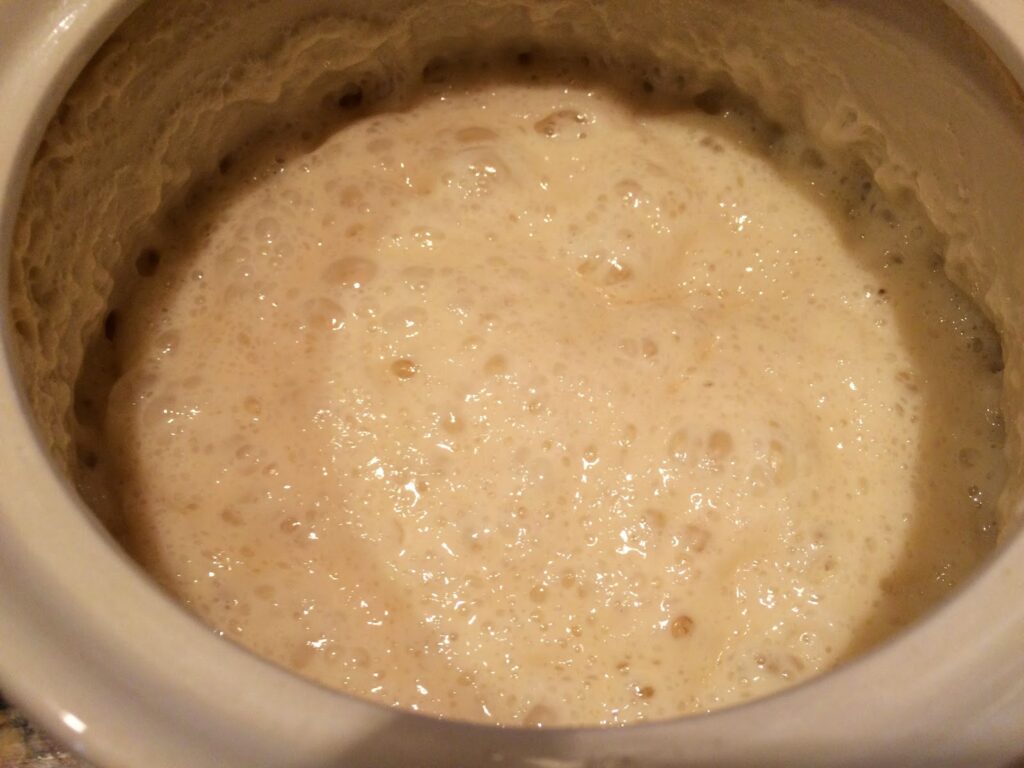 |
| Sourdough Starter |
I make various types of sourdough breads, pancakes, waffles, doughnuts, cakes, and more all the time. I’ve been using the same sourdough starter for several years, and I’ve heard of some places that have the same starter that has been passed down from generation to general for more than 100 years! It makes delicious breads of all kinds. I have recipes for two different sourdoughs, one is a sweet sourdough starter, and the other a traditional sourdough starter. I’ll include both recipes here and when I post recipes I’ll let you know which sourdough starter is used in each recipe… either the sweet sourdough starter, or the traditional sourdough starter.
The best thing about sourdough starter is it’s very forgivable! It’s really a living organism, but if you forget to “feed” it or “tend” it, it is very hardy and you can easily rescue it and “bring it back to life”.
At the end of the recipes I’ll share some tips on caring for your starter, and rescue remedies.
Feel free to experiment with all kinds of bread recipes with the sourdough starter. It’s a big hit!
- 1 pkg. dry yeast
- 1/2 cups warm water (110 degrees F)
- 2 cups milk
- 2 cups flour
- 1 Tablespoon sugar
Dissolve the yeast in warm water in a large non-metal bowl or crock and let stand for about 5 minutes. Using a non-metal spoon or whisk stir in flour, sugar and milk and stir or whisk until smooth. Cover with a cheesecloth, towel, or loose lid. Let stand at room temperature for 5 days, stirring 2-3 times a day.
On the 5th day you are ready to use your starter!
Keeping your starter going: After using some starter, add 3/4 cup milk, 3/4 cup flour, and 1 teaspoon sugar to the remaining starter. Whisk and leave at room temperature, covered with cheesecloth or loose lid. Stir once a day. If you don’t use any starter after 10 days, add 1 teaspoon sugar to keep it going. Make sure to stir daily. Repeat adding sugar every 10 days if necessary.
- 1 pkg. dry yeast
- 1/4 cup warm water (110 degrees F)
- 1 cup flour
- 1 cup sugar
- 1 cup warm milk
Dissolve the yeast in warm water in a large non-metal bowl or crock and land let stand for about 5 minutes. Using a non-metal spoon or whisk stir in flour, sugar and milk and stir or whisk until smooth. Stir once a day for the next 4 days (this is a 10 day process).
On the 5th day add 1 cup flour, 1 cup sugar, and 1 cup milk (doesn’t have to be warm). Stir until smooth. Stir once a day for the next 4 days.
On day 10 you are ready to use your starter!
Keeping your starter going: After using some starter, add 1 cup milk, 1 cup flour, and 1 cup sugar to the remaining starter. Whisk and
leave at room temperature, covered with cheesecloth or loose lid. Stir
once a day. If you don’t use any starter after 10 days, add 1 teaspoon
sugar to keep it going. Make sure to stir daily. Repeat adding sugar every 10 days if necessary.
TIPS:
SMELL: Sourdough starter should be yeasty, fermenting, and beer-like. If it smells sharp and hasn’t been fed
in the past 4-6 days, feed it and then check the smell in 1-2 days, it should smell better.
COLOR & APPEARANCE: Creamy, off-white, not gray-ish, and consistency of pancake batter, but on warm days can be thicker and more bubbly.
BUBBLES: After a feeding, it should be active and bubbly within 24 hours. On
other days it may be flat like pancake batter, but a quick stir should
reveal a few bubbles. It’s important to stir on a daily basis, just to make sure all the ingredients
have a chance to get metabolized.
WHY NOT METAL BOWLS OR UTENSILS? There is a chemical reaction that happens between the fermenting starter and metal. You’ll know this has
happened because your batter will turn color, usually green or sometimes
pink, and while some people have said the bread still tastes fine,
there is a definite metallic taste to it. Now if your metal utensils
and bowls are stainless steel or coated, for example, you’re probably
fine (most KitchenAid mixers shouldn’t be a problem). But if
they’re scratched up in any way, it can turn and spoil your starter
almost instantly.
STORING STARTER: You can store your starter in a glass, ceramic, or plastic mixing bowls,
jar, and Ziploc bags, at room temperature. Just make sure there’s enough room for
the starter to grow and expand, otherwise you could have a mess on your
hands.
REVIVING STARTER: If you forgot to stir or feed your starter for a few days it’s usually fine, just give it a stir and it should be fine. If it’s been 4-5 days, feed it the flour, sugar and milk and stir daily for the next few days and you’ll be fine.
TOO MUCH STARTER, NEED A BREAK? If you have too much starter or need to take a break for a bit you can either give some away, dump some of it, or you can freeze your starter. Put 1-2 cups of starter in a large zip top bag and pop it in the freezer. It won’t freeze completely but will become more like a semi-firm slushy. When you want to use it again take it out of the freezer and let it come to room temperature on your counter, feed it, and then you can use it again and keep it going.
This also makes great gifts, give some sourdough starter along with a
couple recipes. You can divide your starter in half when ready to use,
and have 2 starters going, then divide those in half again and you have
several going to give as gifts.
